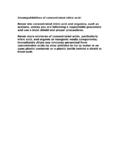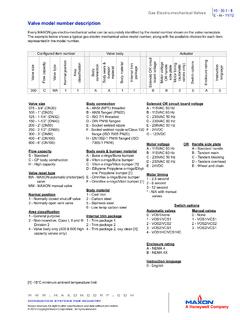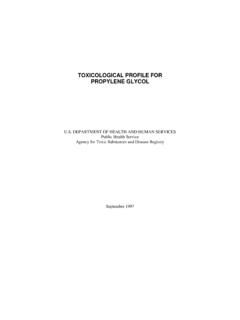Transcription of PROPYLENE GLYCOL 99% SAFETY DATA SHEET 2017 …
1 1 PROPYLENE GLYCOL 99% SAFETY DATA SHEET SEC T I ON 1 . C HEMI CAL PRODUC T AN D C OMPAN Y I DENT I FI C AT I ON Product Name: PROPYLENE GLYCOL 99% General or Generic ID: Propane 1,2-diol; 1,2-dihydroxypropane; methyl-ethylene GLYCOL ; mono- PROPYLENE GLYCOL Manufacturer s Name: (same as Supplier) Inland Technologies International Ltd. Box 253, 14 Queen Street Truro, Nova Scotia B2N 5C1 Canada Phone: 1-877-633-5263 Recommended Use: De-icing/Anti-icing applications, antifreeze agents, mining chemicals. Restricted Use: There are no uses advised against.
2 Emergency Telephone: CANUTEC: 613-996-6666 or *666 on a cellular phone SEC T I ON 2 . HAZARDS IDEN T I FI C AT I ON Hazard Classification Health Hazards: Health 0 Flammability 1 Physical Hazard 0 Hazard statement: This material is NOT HAZARDOUS by OSHA Hazard Communication definition. PROPYLENE GLYCOL is a slightly combustible liquid. Do not handle near heat, sparks or open flame. May cause eye irritation. High aerosol concentrations may cause mild irritation of the nose and throat as well as central nervous system depression. Not expected to cause skin irritation.
3 Not expected to be a sensitizer. Other hazards which do not result in GHS classification: None. SEC T I ON 3. C OMPOSI T I ON / I N FORMATI ON ON I N G REDIEN TS Chemical Identity Common name and synonyms CAS number Content in Percent (%) PROPYLENE GLYCOL GLYCOL , 1,2 - propandiol 57-55-6 99 100% 2017 2 SEC T I ON 4 . FI RST AI D MEASURES General information: Get medical advice/attention if you feel unwell.
4 Show this SAFETY data SHEET to the doctor in advance. Ingestion: Call a physician or poison control center immediately. Do not induce vomiting without advice from poison control center. Never give liquid to an unconscious person. If vomiting occurs, keep head low so that stomach content doesn t get into lungs. Inhalation: Move to fresh air. Treat symptomatically. Get medical attention if symptoms persist. Skin contact: Wash skin thoroughly with soap and water. Get medical attention if irritation persists after washing. Eye contact: Immediately flush with plenty of water for at least 15 minutes.
5 If easy to do, remove contact lenses. Get medical attention. Most important symptoms/effects, acute and delayed: Symptoms: May irritate eyes. Harmful if swallowed. Indication of immediate medical attention and special treatment needed: Treatment: Treat symptomatically. Symptoms may be delayed. SEC T I ON 5 . FI RE FIG HTI N G MEASURES General fire hazards: In case of fire and/or explosion, do not breathe fumes. Suitable and unsuitable extinguishing media: Suitable extinguishing media: Water spray, foam, dry powder or carbon dioxide.
6 Unsuitable extinguishing media: Direct water spray will spread fire. Specific hazards of arising from chemical: Fire may produce irritating, corrosive and/or toxic gases. Special protective equipment and precautions for firefighters: Special firefighting procedures: Move containers from fire area if you can do so without risk. Use water spray to keep fire-exposed containers cool. Cool containers exposed to flames with water until well after the fire is out. Special protective equipment for firefighters: Firefighters must use standard protective equipment including flame retardant coat, helmet with face shield, gloves, rubber boots, and in enclosed spaces, SCBA.
7 SEC T I ON 6 . AC C I DENTAL RELEASE MEASURES Personal precautions, protective equipment and emergency procedures: Use personal protective equipment. Keep unauthorized personnel away. Keep up-wind. Ventiliate closed spaces before entering them. Methods and material for containment and cleaning: Absorb spill with vermiculite or other inert material, then place in a container for chemical waste. Clean surface thoroughly to remove residual contamination. Dike far ahead of larger spill for later recovery and disposal.
8 Notification procedures: Dike for later disposal. Prevent entry into waterways, sewers, basements or confined areas. Stop the flow of material, if this is without risk. Inform authorities if large amounts are involved. Environmental precautions: Do not contaminate water sources or sewer. Prevent further leakage or spillage if safe to do so. Avoid discharge into drains, watercourses or onto the ground. 3 SEC T I ON 7 . HAN DLI NG AN D ST ORAG E Precautions for safe handling: Use personal protective equipment as required.
9 Do not breathe mist or vapour. Avoid contact with eyes, skin and clothing. Do not taste or swallow. Wash hands thoroughly after handling. Do not handleuntil all SAFETY precautions have been read and understood. Obtain special instructions before use. Conditions for safe storage: (including any incompatibilities) Keep container tightly closed. Store in well-ventilated place. Store in a dry place. Store in a locked or controlled access area. SEC T I ON 8 . EX POSURE C ON T ROLS/ PERSON AL PROT EC T I ON Control Parameters: Occupational Exposure Limits: Chemical Identity Type Exposure Limit Values Source PROPYLENE GLYCOL Ceiling 50 PPM 125mg/m3 US.
10 OSHA VPEL PROPYLENE GLYCOL - Aerosol Ceiling 100mg/m3 ACGIH TLV Engineering Controls: Maintain sufficient mechanical (general and/or local exhaust) ventilation to maintain exposure below TLVs. Individual protection measures, such as personal protective equipment: General information: Good general ventilation (typically 10 air exchanges per hour) should be used. Ventilation rates should be matched to conditions. If applicable, use process enclosures, local exhust ventilation, or other engineering controls to maintain airborne levels below recommended exposure limts.






